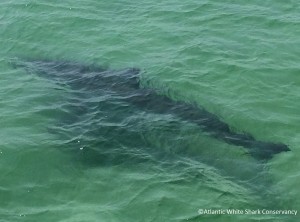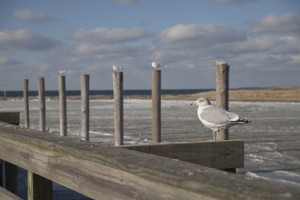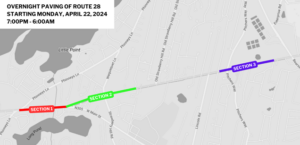
PHOTO COURTESY OF THE ATLANTIC WHITE SHARK CONSERVANCY. The first Great White Shark of the season was tagged by state shark expert Greg Skomal off Monomoy on Thursday, July 31.
CHATHAM – Last week’s tagging of a great white shark in Chatham waters is part of a major shark population study being undertaken this summer by the Atlantic White Shark Conservancy.
The great white shark tagged last week was the first one tagged this summer in coastal waters off the Cape. It was one of three great white sharks seen by researchers off Orleans and Chatham last Tuesday.
Researchers associated with the Atlantic White Shark Conservancy tagged the 12-footer a few hundred yards from shore in Chatham.
By tagging sharks, state scientists will be able to track the sharks and study them for a population study of the creatures.
Cynthia Wigren, president of the conservancy, said Thursday’s trip was the best of the season for the shark researchers.
The population study, she said, is “to learn more where the sharks might be breeding, where the sharks are potentially giving birth, truly what their movement patterns are.”
The study will run through mid-October and researchers have been out two or three days a week with a spotter plane in the air since the study began in June.
“We had a really exciting day on the water today,” she said hours after the tagging.
Before tagging the shark, the group saw their first shark of the day off Nauset Beach close to the Nauset inlet and a couple hundred yards from the beach. The spotter plane the scientists work with alerted them to that shark, which was approximately 12 feet long.
They lost sight of that shark but then they were guided to a second great white shark off Chatham, north of the Chatham Harbor inlet.
They got video of the second shark, also an approximately 12-foot fish, and also tagged it.
After tagging the shark, the group then ran across a third shark right outside of the Chatham Harbor inlet. The group thought at first it was the shark they had just tagged but when they got close to it, they realized it was an untagged shark.
While it was a different animal than the one that they had just tagged, but it was not conclusive whether it could have been the one they had seen earlier off Nauset Beach, Wigren said.
She said she did not know the length of the third shark.
“There was so much excitement that it was something different when we thought we were going to get additional footage of the tagged shark,” she said.
The group can only tag a shark when conditions are right for them to get close enough to the animal, Wigren said. “Today happened to be one of those opportunities,” she said.
The scientists took video footage of all three sharks, so they may be able to tell whether two of the sharks were the same creature. They can identify the sharks from the lateral lines along the gills where the grey turns to white.
“We may have seen three sharks today. We defnitely saw two sharks, possibly three,” she said. That would be the first time the scientists have seen more than one during a single trip this summer.
Since late June, the crew has been out in waters off Cape Cod twice a week looking for great white sharks for a population study of the animals. They saw their first great white on June 28 in Cape Cod waters and have seen or seen conclusive evidence of about 10 great whites since then.
But yesterday’s shark off Monomoy was the first one to be tagged.
























